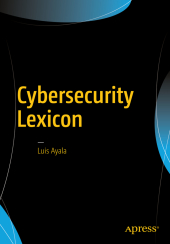 Neuerscheinungen 2016Stand: 2020-02-01 |
Schnellsuche
ISBN/Stichwort/Autor
|
Herderstraße 10
10625 Berlin
Tel.: 030 315 714 16
Fax 030 315 714 14
info@buchspektrum.de |

Luis Ayala
Cybersecurity Lexicon
1st ed. 2016. xi, 200 S. 1 SW-Abb. 254 mm
Verlag/Jahr: SPRINGER, BERLIN; APRESS 2016
ISBN: 1-484-22067-6 (1484220676)
Neue ISBN: 978-1-484-22067-2 (9781484220672)
Preis und Lieferzeit: Bitte klicken
Learn the threats and vulnerabilities of critical infrastructure to cybersecurity attack. Definitions are provided for cybersecurity technical terminology and hacker jargon related to automated control systems common to buildings, utilities, and industry.
Buildings today are automated because the systems are complicated and so we depend on the building controls system (BCS) to operate the equipment. We also depend on a computerized maintenance management system (CMMS) to keep a record of what was repaired and to schedule required maintenance. SCADA, BCS, and CMMS all can be hacked.
The Cybersecurity Lexicon puts cyber jargon related to building controls all in one place. The book is a handy desk reference for professionals interested in preventing cyber-physical attacks against their facilities in the real world.
Discussion of attacks on automated control systems is clouded by a lack of standard definitions and a general misunderstanding about how bad actors can actually employ cyber technology as a weapon in the real world. This book covers:
Concepts related to cyber-physical attacks and building hacks are listed alphabetically with text easily searchable by key phrase
Definitions are providesd for technical terms related to equipment controls common to industry, utilities, and buildings-much of the terminology also applies to cybersecurity in general
What You´ll learn
Get a simple explanation of cybersecurity attack concepts
Quickly assess the threat of the most common types of cybersecurity attacks to your facilities in real time
Find the definition of facilities, engineering, and cybersecurity acronyms
Who This Book Is For
Architects, engineers, building managers, students, researchers, and consultants interested in cybersecurity attacks against facilities in the real world. Also for IT professionals getting involved in cybersecurity responsibilities.
Chapter 1: .- Chapter 2: A.- Chapter 3: B.- Chapter 4: C.- Chapter 5: D.- Chapter 6: E.- Chapter 7: F.- Chapter 8: G.- Chapter 9: H.- Chapter 10: I.- Chapter 11: J.- Chapter 12: K.- Chapter 13: L.- Chapter 14: M.- Chapter 15: N.- Chapter 16: O.- Chapter 17: P.- Chapter 18: Q.- Chapter 19: R.- Chapter 20: S.- Chapter 21: T.- Chapter 22: U.- Chapter 23: V.- Chapter 24: W.- Chapter 25: X.- Chapter 26: Y.- Chapter 27: Z.- Chapter 28: Facilities, Engineering, and Cyber Acronyms.- Chapter 29: Cyber Standards.
Luis Ayala worked over 25 years for the Department of Defense with the past 11 years at the Defense Intelligence Agency. Prior to his appointment as a Defense Intelligence Senior Leader in 2008, he held several leadership positions at the Branch and Division levels.
His tenure culminated with the position as Senior Technical Expert (facilities/construction). Mr. Ayala earned his Bachelor of Architecture degree from Pratt Institute and he received his Master of Science and Technology Intelligence from the National Intelligence University. NIU is the Intelligence Community´s sole accredited, federal degree granting institution. His Master´s thesis titled "Cybersecure Facilities for the Intelligence Community" is classified. Mr. Ayala was awarded the DIA Civilian Expeditionary Medal and the Civilian Combat Support Medal.


